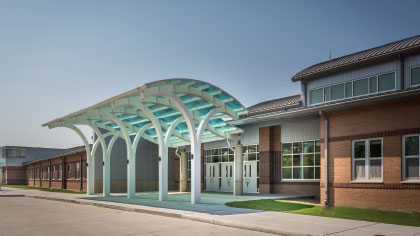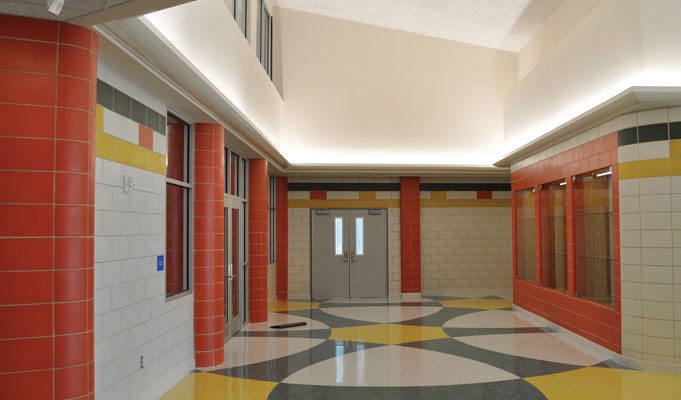Arlene Meraux Elementary, glazed CMU interior
Monumental devastation from 2017’s hurricanes Irving, Maria, and Jose has caused architects and building professionals to look back at lessons learned from Hurricane Katrina, which devastated New Orleans in August 2005. With sustained winds of 100-140 mph and storm surges as high as almost 30 feet, about 80 percent of the city was underwater. The storm heavily damaged or destroyed more than 120 schools from the New Orleans school district alone. Remarkably, 12 years later, the region is still rebuilding as student populations in many districts continue to increase.
Architect Peter Fortier, AIA, EDAC of Lachin Architects, APC in New Orleans, is a proponent of masonry for the rebuilding efforts because he witnessed its ability to withstand flooding. “When we first surveyed the post-Katrina damage, we took note of construction materials that survived. Glazed concrete block and glazed tile best weathered the inundation and could be cleaned and reused,” he says.
GLAZED CMU
When designing Arlene Meraux Elementary in St. Bernard Parish, he was faced with a tight construction schedule and a site that faced the potential for future floods. He chose glazed CMU to help meet the district’s immediate and long-term needs.
For Arlene Meraux Elementary, Fortier designed all interior walls with Trenwyth Astra-Glaze SW+® glazed concrete units to a minimum of 10 feet high. He also raised all critical mechanical and electrical systems out of harm’s way to the second level. As such, the building not only met but exceeded the Federal Emergency Management Agency’s (FEMA) criteria for how high to raise a building’s slab, a benchmark for qualifying for flood insurance.
Working closely with Fortier on the Arlene Meraux Elementary School, Randy Rush, owner, Rush Masonry in New Orleans has worked on approximately 70 percent of the rebuilding projects in the New Orleans metro area. Rush typically works with designers and architects on the front end to help facilitate the design process and materials specs. Whenever possible, he encourages designers to choose Oldcastle Echelon’s Trenwyth products.
“Since Katrina, we’ve been seeing a lot more glazed CMU, ground face CMU, and interior CMU partitions because the materials are better able to withstand flooding and are easier to clean up afterward,” says Rush.

Arlene Meraux Elementary, St. Bernard Parish, New Orleans
STRENGTH OF MASONRY
Because flooding is only one source of the damage inflicted by hurricanes, it was also necessary to design to withstand high winds. A storm’s winds can propel objects through the building, injuring people inside, and can tear a building apart through uplift.
“Wind is not an issue when you build with masonry due to the stringent load requirements established by the International Building Code (IBC) for masonry, especially when you do steel-reinforced construction,” asserts Fortier. “And, when you use a glazed masonry, it not only stands up to natural forces, but student wear and tear as well.”
For aesthetics and practicality, he established a multi-color palette, with a separate color theme created for each wing. “Color-coding is a better way to help K-5 students identify the different areas of the school than signage, which is another benefit of glazed masonry,” he explains.
Rush notes he liked the glazed masonry for this application because there are no color problems with staining the CMU, since the color is glazed onto the masonry. “The masonry on this project is the best-looking aspect of the design.”
Arlene Meraux Elementary opened its doors to nearly 550 students this past August, in time for the 2017-2018 school year. The 115,000-square-foot, newly built, state-of-the-art facility sits on a 14.6-acre plot of land donated by The Arlene and Joseph Meraux Charitable Foundation.
Although a typical schedule for a school of this size would be 15 months, this project was completed in 12 months without incurring serious overages or overtime charges.
Using glazed masonry was one of the value-engineering methods used to meet the stringent timeline. “One of the advantages of glazed masonry is that once the product is in place, no painting is needed. Eliminating that step saves a good deal of time,” says Fortier.
REBIRTH AND REBUILD
Fortier has done as many as 20 projects for the St. Bernard Parish School Board. “Wherever there was new construction, we utilized glazed CMU, and all but one used Astra-Glaze,” he says. “I’ve been very happy with the product. I primarily use it on the interior because it performs well. I also sometimes use it on the exterior as an accent to brick.”
“What’s taking place in New Orleans now is a fusion of rebirth and rebuild,” says Steve Rome, AIA, principal partner of Verges Rome Architects in New Orleans.
The firm was tasked with designing the South Plaquemines Elementary School, which was fast-tracked to open for the 2014-2015 school year to a large student population. The $30.9 million project was funded by FEMA and designed to comply with the agency’s strict mitigation requirements. The 105,054 square-foot, two-level structure was raised 18 feet above grade to mitigate future flooding from a surge of the Gulf of Mexico. The building’s ground level comprises a covered outdoor play and parking area, rather than occupied areas. “We want the bottom floor to be a wash-out, so use masonry at least from ground level up to the first floor. We then use masonry veneer and other waterproof or water-resistant materials on the face,” explains Rome.
Oldcastle Echelon’s Trendstone Plus® was used on the school’s interior. “We chose it because it provided the aesthetic we wanted, is low-maintenance and durable. Masonry is just a good material to use where there’s the potential for water. Most masonry structures are going to survive a flood,” says Rome. “They may need some cleaning and finishing touches, but still won’t constitute structural damage. Masonry is a good lifecycle and aesthetic material for buildings.”
Rome adds, “We learned many lessons after Katrina about the resistance of water and wind. The code in New Orleans now balances the potential for disaster with the reality of the construction industry.”
CONCLUSION
In storm-prone areas such as New Orleans, a building’s durability and resilience are often as important—or more so—than its aesthetics. The use of glazed CMU enables designers to be creative and inspiring in their designs while protecting clients’ long-term investment. Important learnings for the daunting rebuilding efforts ahead in Florida, Texas, and Puerto Rico.
FOR MORE INFORMATION
For generations, Oldcastle has been North America’s leading manufacturer of architectural masonry products and materials. Now Oldcastle embarks on a new journey, consolidating its many masonry products, services, and expertise into the single brand of Echelon. For more information, visit www.echelonmasonry.com.
_________________________________________________________________________
Modern Contractor Solutions, July 2018
Did you enjoy this article?
Subscribe to the FREE Digital Edition of Modern Contractor Solutions magazine.



